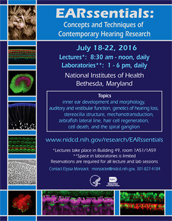Thanks to all who attended the 2016 EARssentials course. Watch videocasts of the lectures and Q&A sessions from EARssentials 2016:
- Day 1 (Monday, 7/18/16): Course introduction. Introduction to the auditory system. Auditory mechanics and the traveling wave. History of auditory research.
- Day 2 (Tuesday, 7/19/16): Introduction to the vestibular system. Development of the inner ear. Spiral ganglion.
- Day 3 (Wednesday, 7/20/16): The stereocilia bundle and mechanotransduction. Hair cells/hair cell death/age-related hearing loss/protection.
- Day 4 (Thursday, 7/21/16): Hair cell regeneration. The hair cell synapse. Efferent regulation of auditory function.
- Day 5 (Friday, 7/22/16): Lateral line. Genetics of hearing loss. Clinical treatments. Introduction to gene profiling and bioinformatics.
July 18-22, 2016
National Institutes of Health
Bethesda, MD
This free, week-long course, hosted and taught by scientists at the National Institute on Deafness and Other Communication Disorders (NIDCD), part of the National Institutes of Health (NIH), will provide students with an overall conceptual view of the auditory system as well as hands-on exposure to laboratory techniques unique to research on the inner ear.
The primary audience for this course is new intramural NIDCD trainees, including post-doctoral, graduate, post-baccalaureate, and summer students. Scientists from other institutions are welcome to attend as well. The course will also be useful for other interested individuals who want to learn about concepts related to the auditory system.
The class is divided into two segments:
- Lecture sessions in the mornings, in which scientists introduce and discuss a wide array of concepts related to the auditory system. Lectures are open to all who register. Contact Elyssa Monzack, Ph.D., for more information.
- Hands-on laboratory sessions in the afternoon. Each session will feature a different technique commonly used in hearing and balance research. All lab sessions are now full.
All lectures will be held in building 49, room 1A51/1A59. All laboratory sessions will held in the Porter Neuroscience Research Center, building 35A.
Monday, July 18
| Time |
Presentation |
| 8:30-9:00 a.m |
Course introduction—Elyssa Monzack
(30 min)
|
| 9:00-10:00 a.m. |
Lecture: Introduction to the auditory system—Andrew Griffith
(60 min)
|
| 10:00-10:20 a.m. |
Auditory system Q&A
(20 min)
|
| 10:20-10:35 a.m. |
Break
(15 min) |
| 10:35-11:35 a.m. |
Lecture: Auditory mechanics and the traveling wave—Kelly King
(60 min)
|
| 11:35-11:55 a.m. |
Auditory mechanics Q&A
(20 min)
|
11:55 a.m.-
1:00 p.m. |
Lunch break
|
| 1:00-1:45 p.m. |
Lecture: History of auditory research—Matthew Kelley
(45 min)
|
| 1:45-6:00 p.m. |
Laboratory session: Auditory brainstem response/distortion product otoacoustic emissions—Tracy Fitzgerald/Elizabeth Wilson
|
|
Tuesday, July 19
| Time |
Presentation |
| 8:30-9:30 a.m. |
Lecture: Introduction to the vestibular system—Christopher Zalewski
(60 min)
|
| 9:30-9:50 a.m. |
Vestibular system Q&A
(20 min)
|
| 9:50-10:00 a.m. |
Break
(10 min)
|
10:00-
10:55 a.m. |
Lecture: Development of the inner ear—Doris Wu
(55 min)
|
| 10:55-11:05 a.m. |
Break
(10 min)
|
| 11:05 a.m.-12:00 p.m. |
Lecture: Spiral ganglion—Thomas Coate (55 min)
|
| 12:00-1:00 p.m. |
Lunch break
|
| 1:00-4:30 p.m. |
Laboratory session: Dissection of cochlea and utricle—Matthew Kelley/Lisa Cunningham labs
|
|
4:30-6:00 p.m.
|
Lab tutorial: Inner ear paint fill demonstration—Doris Wu
|
|
Wednesday, July 20
| Time |
Presentation |
| 8:30-9:30 a.m. |
Lecture: The stereocilia bundle and mechanotransduction (I)—Gwenaelle Geleoc
(60 min)
|
| 9:30-9:40 a.m. |
Break
(10 min)
|
| 9:40-10:40 a.m. |
Lecture: The stereocilia bundle and mechanotransduction (II)—Gwenaelle Geleoc
(60 min)
|
| 10:40-10:50 a.m. |
Break
(10 min) |
| 10:50-11:50 a.m. |
Lecture: Hair cells/hair cell death/age-related hearing loss/protection—
Lisa Cunningham
(60 min)
|
| 11:50 a.m.-1:00 p.m. |
Lunch break
|
| 1:00-3:30 p.m. |
Laboratory session: Scanning electron microscopy
—Inna Belyantseva/Evan Krystofiak
|
Laboratory session: Confocal and live imaging microscopy—Elizabeth Driver
|
| 3:30-6:00 p.m. |
Laboratory session: Transmission electron microscopy
—Ronald Petralia
|
|
Thursday, July 21
| Time |
Presentation |
| 8:30-9:30 a.m. |
Lecture: Hair cell regeneration—Matthew Kelley
(60 minutes)
|
| 9:30-9:40 a.m. |
Break
(10 min)
|
| 9:40-10:40 a.m. |
Lecture: The hair cell synapse—Paul Fuchs/Catherine Weisz
(60 min)
|
| 10:40-10:50 a.m. |
Break
(10 min)
|
| 10:50-11:50 a.m. |
Lecture: Efferent regulation of auditory function—Paul Fuchs/Catherine Weisz
(60 min)
|
| 11:50 a.m.-1:00 p.m. |
Lunch break
|
| 1:00-3:30 p.m. |
Laboratory session: Confocal and live imaging microscopy—Elizabeth Driver
|
Laboratory session: Transmission electron microscopy
—Ronald Petralia
|
Laboratory session: Scanning electron microscopy
—Inna Belyantseva/Evan Krystofiak
|
| 3:30-6:00 p.m. |
|
|
Friday, July 22
| Time |
Presentation |
8:30-
9:30 a.m. |
Lecture: Lateral line—Katie Kindt
(60 min)
|
| 9:30-9:40 a.m. |
Break
(10 min) |
| 9:40-10:40 a.m. |
Lecture: Genetics of hearing loss—Thomas Friedman
(60 min)
|
| 10:40-10:50 a.m. |
Break
(10 min)
|
| 10:50-11:35 a.m. |
Lecture: Clinical treatments — Michael Hoa
(45 Min)
|
| 11:35 a.m.-12:30 p.m. |
Lunch break
|
| 12:30-1:15 p.m. |
Lecture: Introduction to gene profiling and bioinformatics—Michael Kelly
(45 min)
|
| 1:15-6:00 p.m. |
Laboratory session: Mouse genetics
—TBA
|
Laboratory session: Zebrafish orientation—Katie Kindt
|
|
|
Faculty
Inna Belyantseva, M.D., Ph.D.
Thomas Coate, Ph.D.
Lisa Cunningham, Ph.D.
Elizabeth Driver, Ph.D.
Tracy Fitzgerald, Ph.D.
Thomas Friedman, Ph.D.
Paul Fuchs, Ph.D.
Gwynaelle Geleoc, Ph.D.
Andrew Griffith, M.D., Ph.D.
Michael Hoa, M.D.
Matthew Kelley, Ph.D.
Michael Kelly, Ph.D.
Katie Kindt, Ph.D.
Kelly King, Au.D., Ph.D.
Evan Krystofiak, Ph.D.
Elyssa Monzack, Ph.D.
Ronald Petralia, Ph.D.
Catherine Weisz, Ph.D.
Elizabeth Wilson, B.S.
Doris Wu, Ph.D.
Christopher Zalewski, Ph.D.
Contact information
Reservations are required for all sessions. To attend a lecture, contact Dr. Monzack. All lab sessions are currently full.

* Note: PDF files require a viewer such as the free Adobe Reader.



